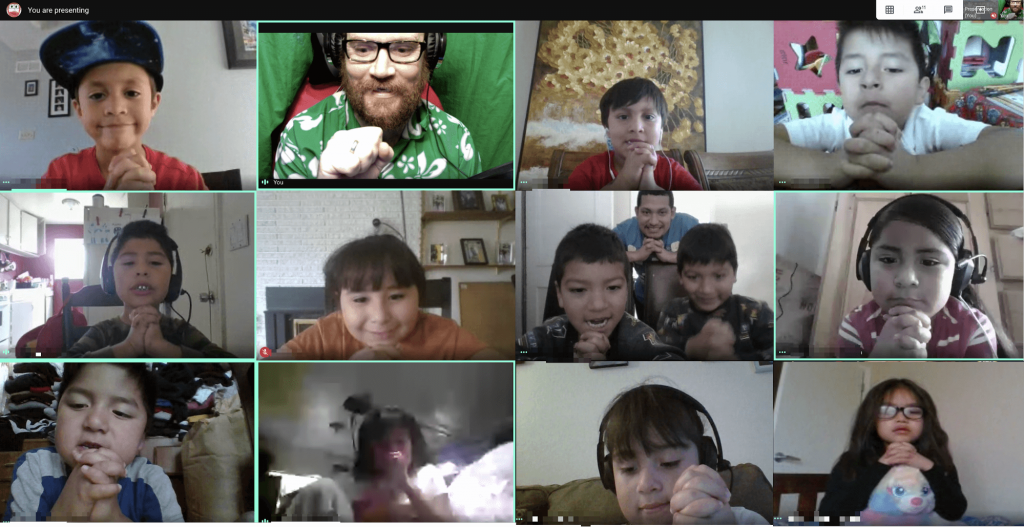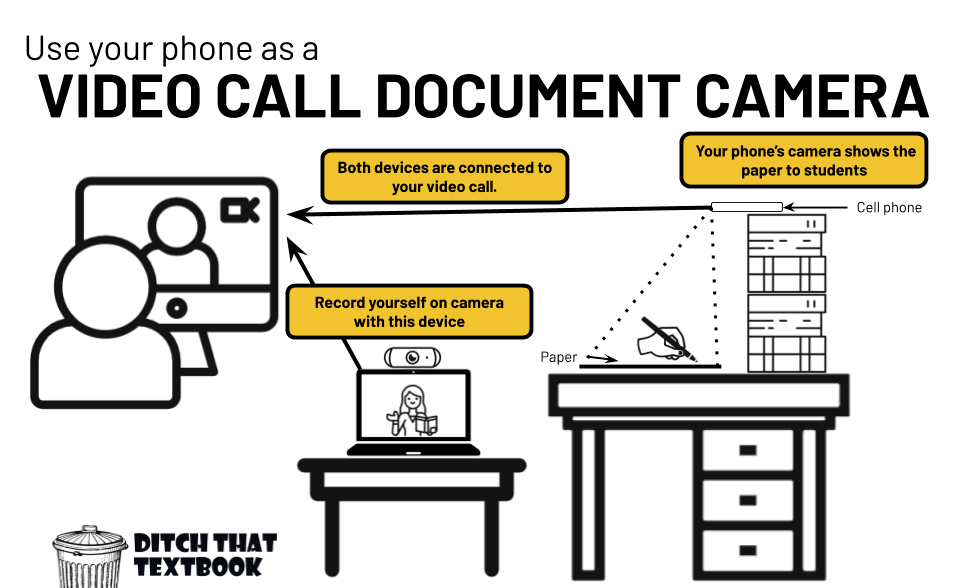
Our kindergarten through second grade students (and teachers!) need special assistance during distance learning. Here are 10 ways to make it work.
This post is written by Ben Cogswell, Eric Garcia and Michael Hughes. Ben currently teaches kindergarten in Salinas, California. Eric is a 5th Grade STEAM Science/PE Teacher in McFarland, CA. Michael is currently teaching 4th grade after years of teaching TK and kindergarten in Riverside County. You can connect with them on Twitter @cogswell_ben, @EdTechGarcia and @LakersHughes.
Distance learning provides many challenges for students and teachers. For those of us in the youngest grades the challenges that we and our students face seems even more difficult.
Trying to engage even one 5 year old on a Zoom or Google Meet call can be challenging. Trying to teach an entire class is a whole other level.
But it CAN be done! And it can be done well.
Check out the interview below to hear Ben and Micheal share their thoughts along with tons of resources below. Then scroll down for 10 ways to make distance learning work in K-2!
Here are 10 ways to make distance learning work in K-2.
1. Support the families
The family members are our students’ first teachers. Families should be considered co-teachers in your classroom. Bring them into the learning space and treat them as a member of the class community.
Tips for success:
- Give families the tools they need to understand how to access your class. Make tutorials specifically for parents (Screencastify and Flipgrid make this easy to do!). Find someone to help you with the translation (Principal, other teacher, friend) so that the information is accessible to everyone.
- Consider having a class Facebook page. You can include tech training for parents and/or use it to connect to engage the kids with activities outside of their academic day (art, yoga, zumba). This page can also serve as a place to go to ask and answer questions.
- One on one meetings go far. Try to connect with parents and help them understand that you are there for them. They are new to this all as well. A simple phone call asking how they are doing will really help them know that you’re all in this together.
- Use Facetime, Google Meet, or Facebook Messenger to assist with tech or others issues. Sometimes parents can’t get into the Zoom or Classroom. Get creative with how you are connecting with them.
Resources:
2. Make your own videos for your students
There are TONS of resources out there and using premade videos is OK but making your own videos helps you connect more with kids. Even if it isn’t the perfect lesson students love seeing their teacher. Make it simple! Use your phone, a whiteboard and a tripod and teach your lesson.
Tips for success:
- Make a welcome video that students can see when they enter the class.
- Keep in mind the length of the lesson or the video.
- Add some props to make it fun (i.e., puppets, costumes)
- Use Green Screen for an extra spark. Try using the Doink app for an easy way to bring green screen into your videos.
- If you are using resources from the Seesaw activity library try editing the activity and add your own voice directions or video tutorial.
Resources:
3. Use a document camera during synchronous learning
Get kids engaged on the other side of the screen by using a document camera. Watching you work along with them will help to get kids drawing and writing.
Tips for success:
- You can use your phone as a document camera! This is a fun hack that's easier than you'd think! Start a video call. Then use a second device -- a smartphone is best -- and join the video call with it. Set the phone on a tall stack of books (or purchase an inexpensive phone holder) with the camera facing down at a paper (or small whiteboard). Instant document camera! (Tip and infographic from Matt)
- Draw and write as much as possible. Activities like directed drawings are fun.
- Take a picture of the class holding up their work toward the end as a form of assessment. You can also have students take a picture of their work and add it to their Seesaw journal.

Resources:
- Arthub for Kids (an excellent library of directed drawing tutorials)
- 10 online whiteboard options for remote learning
4. Add colors on keyboards for easier login
For many of our little ones this is the very first time they have logged onto a device. And for those using Chromebooks or laptops the letters on the keyboard look like nonsense if they don’t have letter recognition yet. So let's make it as easy as we can for our little to login! Using colors will help students easily identify where to look on the keyboard as they login.
Tips for success:
- Send home a paper keyboard and have students color each row a different color.
- Send home colored tabs to put on the side of the rows that correspond to the colors on the keyboard.
- Have kids color the keyboard to learn different keys

Resources:
5. Create a one-stop-shop for students and their families
Keep a consistent place (website or even a published Google Slide) for students to access their assignments. Add a page or tab for parents to access the information. Add parent videos and tutorials for help.
Tips for success:
- Keep the content organized to make it easier to find.
- Less is more. The more clicks or tabs that are open the easier it is for students to get lost.
- Create an FAQ page you can send parents too.
- Consider buying a domain name to make it simpler for the kids to remember and log in.
Resources:
6. Treat your Zoom or Meet like a classroom
Set procedures during your zooms. Students need to be aware of noise in their virtual classroom. Just like in the classroom you want to create a good space for learning. Encourage students to be part of creating a good space for learning.
Tips for success:
- Ask ” Can you hear noises in the background?”
- Quiet hands, students put their hands together to be able to show the listening (see picture below).
- Encourage students that are comfortable on camera to have their face in the middle of the screen to make those virtual face to face connections. For students that aren't comfortable with showing their face on camera you can encourage them to use a filter or even use a puppet to be on camera for them.
- Meet with students virtually in small groups to teach them important skills and assess their progress. While the rest of your class is working on their learning tasks asycronously, take a small group to work with. You will get so much more accomplished academically and you will be able to make those connections and build relationships with students in small groups.
- Say hello and goodbye at the end of every meeting.
- Use a bell or noise to signal transitions of my turn your turn .

7. Keep a schedule and be consistent
Be sure to stay consistent with the amount and types of assignments. If kids know what to do we can lessen anxiety for them (and us!). It makes it easier for kids to logon and be at class every single day.
Tips for success:
- Use emojis in front of assignments to help kids see which ones they need to access.
- Build some flexibility in for parents with due dates and class meetings
- Think about times that will work for families.
Resources:


8. Be focused and narrow down your standards
You can’t cover every standard or go page by page in a curriculum so think about what standards are very important (Priority Standards) and focus on those when providing distance learning lessons. Chunk the standards when you teach them. You may need to really pull apart a lesson.
Tips for success:
- SLOW DOWN and breathe!
- Pick the most essential standards. If you could only teacher 5 standards or concepts which would you focus on? What skills do you want the students to know for the next grade level? Work with your team to identify power or anchor standards
- Give yourself grace. No one is doing this perfectly. We will all make mistakes. You're doing the best you can. Don't be upset if things don't turn out the way you expect. Just reflect, breath and move on.
Resources:
9. Make connections with your students as early and often as possible
The earlier you make those connections with your students the better. Take those first couple of days before or right when school starts to meet with each family through a video chat or phone call.
Tips for success:
- Call early and often. The parents want to hear from you!
- Send home postcards. Add a QR code on the postcard with a message not only to the students but also the parents. You can create your video with the Flipgrid shorts camera and easily print the QR code to send to parents.
- Be a calm voice for the kids and families on the other side of the screen
- Consider adding a Flipgrid topic where students can vent and reach out to you anytime. Their videos don't need to be school related. Keep the topic moderated and don't post the videos. They stay between you and the student.
Resources:
10. Make your usual seasonal projects and activities remote
Ask yourself what you would be teaching this time of year. Is it the beginning of the year? Teach routines! Is it time for the cool project you do? Do that project! Just because it is digital doesn’t mean it can’t be done. Take your time and build relationships with your students and families through projects that involve everyone!
Tips for success:
- Teach beginning of the year skills just like you would normally. Skills like holding a pencil, cutting, writing your name are essential and still need to be taught. Be creative and think about how to teach these essential skills over video.
- Get projects that you can send home with students. For example you can send home seeds that students plant with their families. Take your time and build relationships with your students and families through projects that involve everyone!
Resources:
For notifications of new Ditch That Textbook content and helpful links:
Are you looking for quality, meaningful professional learning that both equips and inspires teachers?
Matt provides in-person and virtual keynotes, workshops and breakout sessions that equip, inspire and encourage teachers to create change in their classrooms. Teachers leave with loads of resources. They participate. They laugh. They see tech use and teaching in a new light. Click the link below to contact us and learn how you can bring Matt to your school or district!
Is Matt presenting near you soon? Check out his upcoming live events!







I liked the ideas and want to use a lot of them. Exposing students to fun engaging lessons will be very important and will benefit students and teachers. I believe that teachers need to have a good relationship with students and parents. Consistent procedures and expectations are very important to all stakeholders.
[…] Read the full story by Ditch That Textbook […]